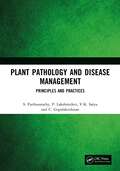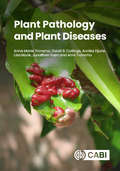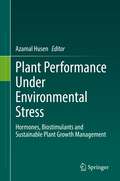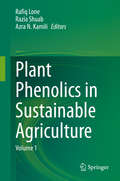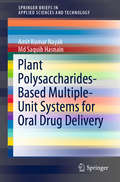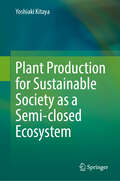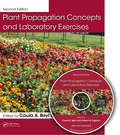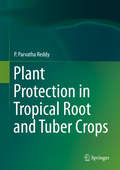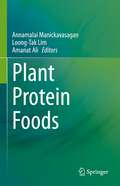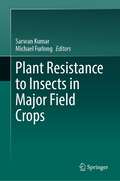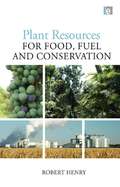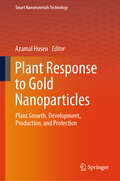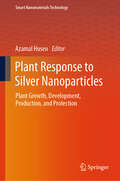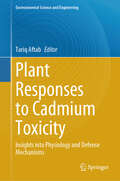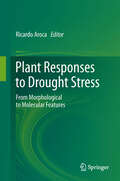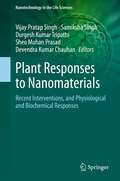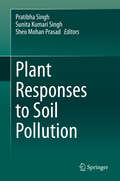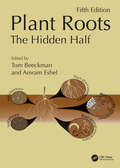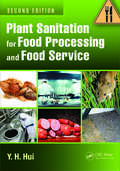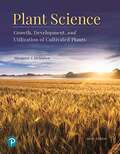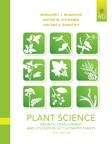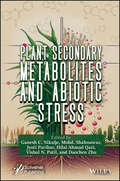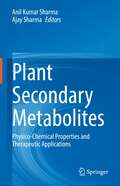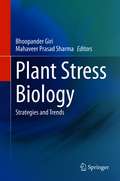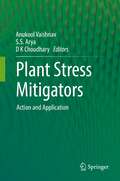- Table View
- List View
Plant Pathology and Disease Management: Principles and Practices
by S. Parthasarathy C. Gopalakrishnan P. Lakshmidevi V.K. SatyaThis book introduces the nature, causes and impact of plant diseases. It briefly describes the history of plant pathology as a scientific discipline and introduces the disease cycle as the key tool for understanding disease development and devising appropriate management strategies. It addresses the mechanisms of pathogenicity and immunity. It explores the biology of the interactions between plants and plant pathogens from the cellular level to the population level, with the chapter addressing epidemiology. The book then concerns the approaches we can take to alleviate the effects of plant pathogens. Print edition not for sale in India.
Plant Pathology and Plant Diseases
by Anne Marte Tronsmo David B Collinge Annika Djurle Lisa Munk Jonathan Yuen Arne TronsmoThis textbook provides a comprehensive introduction to all aspects of plant diseases, including pathogens, plant-pathogen interactions, their management, and future perspectives. Plant diseases limit potential crop production and are responsible for considerable losses in agriculture, horticulture and forestry. Our global food production systems are under increasing pressure from global trade, climate change and urbanization. If we could alleviate the losses due to plant diseases, we would be able to produce roughly 20% more food - enough to feed the predicted world population in 2050. Co-authored by a group of international teachers of plant pathology who have collaborated for many years, the book gives expert and seamless coverage. Plant Pathology and Plant Diseases: Addresses major advances in plant-pathogen interactions, classification of plant pathogens, and the methods of managing or controlling disease Is relevant for a global audience; it covers many examples of diseases with an impact worldwide but with an emphasis on disease of particular importance in a temperate context Features over 400 striking figures and colour photographs It is suitable for graduate students and advanced undergraduates studying plant pathology, biology, agriculture and horticulture.
Plant Performance Under Environmental Stress: Hormones, Biostimulants and Sustainable Plant Growth Management
by Azamal HusenGlobal climate change is bound to create a number of abiotic and biotic stresses in the environment, which would affect the overall growth and productivity of plants. Like other living beings, plants have the ability to protect themselves by evolving various mechanisms against stresses, despite being sessile in nature. They manage to withstand extremes of temperature, drought, flooding, salinity, heavy metals, atmospheric pollution, toxic chemicals and a variety of living organisms, especially viruses, bacteria, fungi, nematodes, insects and arachnids and weeds. Incidence of abiotic stresses may alter the plant-pest interactions by enhancing susceptibility of plants to pathogenic organisms. These interactions often change plant response to abiotic stresses. Plant growth regulators modulate plant responses to biotic and abiotic stresses, and regulate their growth and developmental cascades. A number of physiological and molecular processes that act together in a complex regulatory network, further manage these responses. Crosstalk between autophagy and hormones also occurs to develop tolerance in plants towards multiple abiotic stresses. Similarly, biostimulants, in combination with correct agronomic practices, have shown beneficial effects on plant metabolism due to the hormonal activity that stimulates different metabolic pathways. At the same time, they reduce the use of agrochemicals and impart tolerance to biotic and abiotic stress. Further, the use of bio- and nano-fertilizers seem to hold promise to improve the nutrient use efficiency and hence the plant yield under stressful environments. It has also been shown that the seed priming agents impart stress tolerance. Additionally, tolerance or resistance to stress may also be induced by using specific chemical compounds such as polyamines, proline, glycine betaine, hydrogen sulfide, silicon, β-aminobutyric acid, γ-aminobutyric acid and so on. This book discusses the advances in plant performance under stressful conditions. It should be very useful to graduate students, researchers, and scientists in the fields of botanical science, crop science, agriculture, horticulture, ecological and environmental science.
Plant Phenolics in Sustainable Agriculture: Volume 1
by Rafiq Lone Razia Shuab Azra N. KamiliThis book presents the latest research on plant phenolics, offering readers a detailed, yet comprehensive account of their role in sustainable agriculture. It covers a diverse range of topics, including extraction processes; the role of plant phenolics in growth and development; plant physiology; post-harvesting technologies; food preservation; environmental, biotic and abiotic stress; as well as nutrition and health. Further the book provides readers with an up-to-date review of this dynamic field and sets the direction for future research. Based on the authors’ extensive experience and written in an engaging style, this highly readable book will appeal to scholars from various disciplines. Bringing together work from leading international researchers, it is also a valuable reference resource for academics, researchers, students and teachers wanting to gain insights into the role of plant phenolics in sustainable agriculture.
Plant Polysaccharides-Based Multiple-Unit Systems for Oral Drug Delivery (SpringerBriefs in Applied Sciences and Technology)
by Amit Kumar Nayak Md Saquib HasnainThis book explores the use of various plant polysaccharides for pharmaceutical purposes, including drug delivery. It examines the exploitation of plant polysaccharides’ auxiliary functions to enhance drug release, stability, bioavailability and target specificity. Plant-derived materials are at the center of drug-delivery research thanks to their non-toxicity, biodegradability, ready availability, eco-friendliness and low extraction costs. These materials include polysaccharides, a class of naturally occurring polymers consisting of glucose monomers, which serve as storage carbohydrates in cereals, root vegetables, rhizomes, seeds, fruits, etc.
Plant Production for Sustainable Society as a Semi-closed Ecosystem
by Yoshiaki KitayaThis book introduces the concept of a semi-closed ecosystem, which is necessary for the social implementation of plant production, such as agriculture, in harmony with the environment. While aiming at achieving a sustainable balance of human activities and environmental protection, this book focuses on the material cycle within each semi-closed system listed below. 1) Mangrove forests as semi-closed systems in coastal ecosystems 2) Environmental control in facility-based plant production systems as semi-closed systems 3) Control of the gaseous environment in the root zone as a semi-closed system 4) Controlled ecological life support system as a completely closed ecosystem in space 5) A sustainable balance of human activities and environmental conservation in urban ecosystems. Developing efficient food production with less environmental loads is an important issue. Plant production is vital to human health and welfare, especially in urban areas as semi-closed ecosystems. Producing food efficiently under consideration of environmental protection is necessary with material-cycling systems, especially in semi-closed ecosystems. Establishing a resource recycling production system with reduced waste emissions has also become important in agriculture. Plant production will play an important role not only in food production (Goal 2 in SDGs) but also in many other goals. This book explains how we must regard plant production as semi-closed ecosystems, reduce material and energy resource inputs, and recycle waste emissions generated during production and consumption processes to solve the various issues. Students and researchers studying Agricultural Environmental Engineering, Environmental and Ecological Engineering, Systems Design for Sustainable Society, Environmental Control in Agriculture, etc., will find this publication a helpful reference.
Plant Propagation Concepts and Laboratory Exercises
by Robert N. Trigiano Caula A. BeylIncludes a DVD Containing All Figures and Supplemental Images in PowerPointThis new edition of Plant Propagation Concepts and Laboratory Exercises presents a robust view of modern plant propagation practices such as vegetable grafting and micropropagation. Along with foundation knowledge in anatomy and plant physiology, the book takes a look into t
Plant Protection in Tropical Root and Tuber Crops
by P. Parvatha ReddyThis book is a compilation of information on insect/mite/vertebrate pests and fungal/bacterial/viral/mycoplasma/nematode diseases of tropical root and tuber crops such as cassava, sweet potato, yams, taro, Amorphophallus, yam bean and tannia. The book highlights the distribution, symptoms and damage, biology, survival and spread of each pest and describes management methods. It also sheds light on different eco-friendly pest management strategies including physical, cultural, chemical, biological, host resistance and integrated methods. The book is written in a lucid style using easy-to-understand language and offers adoptable recommendations involving eco-friendly control measures. It serves as a useful reference source for policy makers, research and extension workers, practicing farmers and students. The material can also be used for teaching post graduate courses in state agricultural universities.
Plant Protein Foods
by Loong-Tak Lim Annamalai Manickavasagan Amanat AliRegular consumption of plant-based protein foods instead of animal-based protein foods reduces the risk factors for cardiovascular diseases, diabetes and certain cancers. Apart from human health, the adverse effects to the environment due to the production of protein is much higher for animal sources than plant sources. Greenhouse gas emissions from the production of one pound of lamb meat, for example, are thirty times higher than one pound of lentils.As consumers are increasingly aware of personal health and environmental impact of food production, the demand for plant protein foods is increasing globally. This trend has prompted several large-scale collaborative research projects on plant-based protein products supported by the industry and governmental agencies. Several established multinational meat companies have started adding plant-protein product lines to meet the current demand.This book presents the first comprehensive compilation of literature on plant-based protein foods. Chapters cover protein extraction technologies from plants, comparison of amino acid profiles of plant- and animal-based proteins, approaches to product development for plant-based protein products, health benefits of plant-based protein foods, market opportunities, and future challenges. Plant Protein Foods is an essential reference for consumers, students, researchers, food manufacturers and other stakeholders interested in this domain.
Plant Resistance to Insects in Major Field Crops
by Michael Furlong Sarwan KumarThis edited book is a comprehensive collection of information on host plant resistance to insects in major field crops. The focus of the book is to make the audience aware of the latest developments in host plant resistance in major field crops and how it can be used for sustainable pest management solutions. It deals with the insect-plant interactions, plant defence responses to herbivore attacks, plant phenotyping, and breeding for insect resistance. Insects are an important group of biotic stresses that limit crop productivity in many regions of the world. At present, they are largely managed by synthetic insecticides which have their own adverse effects including insecticide resistance, pest resurgence, environmental pollution, and pesticide residues, to name a few. Thus, there is an urgent need to develop alternate pest management strategies that can provide a sustainable solution to pest problems. Host plant resistance is considered an important pest management strategy as it offers an effective, economical, and environmental friendly solution to pest problems. This book is of interest to postgraduate students, crop entomologists, and breeders working on host plant resistance to insect pests. It is also valuable for teachers, researchers, and climate change scientists.The book serves as an additional reading material for undergraduate and graduate students of agriculture, ecology, and environmental sciences. Agricultural experts from around the world, as well as policymakers, will also find this book helpful.
Plant Resources for Food, Fuel and Conservation
by Robert James HenryAgriculture and food production have a large footprint on the landscape globally and compete for space with land for nature conservation. This book explores the competition between the food needs of a growing human population and the conservation of biodiversity as intensified by the emerging use of crops for energy production. As concern about the impact of greenhouse gas emissions on climate grows and oil prices increase, energy production from agricultural crops has become a significant industry. At the same time, growth in food demand due to population growth has been accelerated by growing affluence associated with economic growth in major developing countries increasing per capita consumption. Consumers are concerned that the price of food will continue to increase sharply as a result of this competition but a loss of biodiversity may be another major outcome. Drawing on his expertise in plant conservation genetics, the author provides a balanced appraisal of the potential for developing new or improved crops for food or bioenergy production in the context of climate change, while at the same time protecting biodiversity.
Plant Response to Gold Nanoparticles: Plant Growth, Development, Production, and Protection (Smart Nanomaterials Technology)
by Azamal HusenIn this book, overall plant and soil system are examined exclusively in terms of gold nanoparticles (Au-NPs) exposure. Au-NPs influence plant growth and yield performance. They also affect plant and soil system interactions. Au-NPs responses are primarily depends on the concentration, plant species or cultivars, exposure time, shape and size of NPs. Investigation have shown that the lower concentrations of Au-NPs increase seed germination, beneficial biochemical components, rate of photosynthesis, and overall growth, however, at higher concentrations, all these responses are declined in different plant species. At higher concentration, Au-NPs induce stress in plant, create phytotoxicity and produce reactive oxygen species which leads to the disruption of cellular metabolism. Further, at higher concentration, Au-NPs hampered the physico-chemical process of plant and soil system. Moreover, the molecular and physiological performance showed that the exposure of Au-NPs resulted in oxidative stress and induced antioxidative and defense responses. The energy production related to metabolic pathways were also influenced by Au-NPs exposure. Au-NPs exposure accelerated the number of chromosomal aberrations, micronuclei, and decreased the mitotic index in plant root tip cells. Proteomic study has shown that the exposure Au-NPs resulted in an accumulation of protein precursors, indicative of the dissipation of a proton motive force. Au ions were noticed in roots and shoots, while Au-NPs were absorbed only in the plant root tissues. Au-NPs exposure also influence flowering process and seed germination. Beside the terrestrial plants, these particles have also influenced the growth of some wetland and aquatic plants. It was also noticed that the addition of Au-NPs into the culture medium had also influence the in vitro development and multiplication of plants. Studies have begun to examine how arbuscular mycorrhizal fungi might affect the uptake of specific nanoparticles include Au and how these particles might influence the plant-mycorrhizal relationships. The impact of Au-NPs on the size and structure of microbial communities in soil; and soil enzymatic activities for β-glucosidase, urease, alkaline phosphatase, and dehydrogenase has been examined. In the present book, environmental safety, and ethical issues related to use of Au-NPs in plant and soil system has been also explored. Overall, this book is provide an up to date, most important and selected information associated with the plant response to Au-NPs. This book will be a good resource for upper-level students, faculty, scientists, and researchers working specially on plant biology, plant nanobiotechnology, plant biochemistry, plant microbiology, agricultural and other allied subjects and or science.
Plant Response to Silver Nanoparticles: Plant Growth, Development, Production, and Protection (Smart Nanomaterials Technology)
by Azamal HusenThis book looks at the plant response to silver nanoparticles (Ag-NPs), which showed both beneficial and harmful effects in a plant system. These responses of Ag-NPs are primarily dependent on the concentration, plant species or cultivars, exposure time, shape, and size of NPs. In general, lower concentrations of Ag-NPs increase seed germination, rate of photosynthesis, and overall growth, but at higher concentrations, all these responses are declined in many plant species. Moreover, Ag-NPs at higher concentration induce stress and or phytotoxicity and produce reactive oxygen species which leads to the disruption of cellular metabolism. Ag-NPs exposure increased the number of chromosomal aberrations, micronuclei, and decreased the mitotic index in plant root tip cells. Proteomic study has shown that the exposure Ag-NPs resulted in an accumulation of protein precursors, indicative of the dissipation of a proton motive force. Ag-NPs also influence transcription of flowering key genes and thus delayed flowering time. A beneficial role of arbuscular mycorrhizal fungi in influencing the effects of Ag-NPs on plant-microbe systems in a soil matrix has been also examined. Beside the terrestrial plants, these particles have also influenced the growth of some wetland and aquatic plants, which are covered in this book. This book provides valuable information to scientists, researchers, and students, working specially on plant biology, plant nanobiotechnology, plant biochemistry, plant microbiology, agricultural and other allied subjects and or science.
Plant Responses to Cadmium Toxicity: Insights into Physiology and Defense Mechanisms (Environmental Science and Engineering)
by Tariq AftabThis book offers an exploration of how plants respond to the presence of cadmium, shedding light on both the physiological and molecular mechanisms In an era of growing environmental concern, this edited book serves as an invaluable resource, shedding light on the intricate interplay between plants and cadmium, a menacing environmental pollutant. Cadmium's pervasive presence in the soil poses a significant threat to plant ecosystems, impacting food security and human well-being. This comprehensive book explores the multifaceted responses of plants to cadmium toxicity, offering critical insights into the physiological and molecular mechanisms governing these reactions. The edited book delves into the intricate relationship between plants and cadmium, a highly toxic heavy metal. Cadmium contamination in the environment, largely stemming from industrial processes and agricultural practices, poses a significant threat to plant ecosystems and, by extension, human and environmental health. This book offers a comprehensive exploration of how plants respond to the presence of cadmium, shedding light on both the physiological and molecular mechanisms that govern these responses. Written by leading experts in the field, this book provides a holistic understanding of the challenges posed by cadmium contamination and the innovative strategies plants employ to combat its detrimental effects. It encompasses a wide array of topics, from the physiological changes plants undergo under cadmium stress to the genetic and molecular pathways activated in response. Furthermore, it explores the practical potential of phytoremediation, a sustainable approach that harnesses plants' abilities to detoxify contaminated environments. This book is a valuable resource for researchers, scholars, and students in the fields of plant biology, environmental science, and toxicology, offering a deep understanding of the challenges presented by cadmiumcontamination and the innovative strategies that plants employ to adapt and thrive in the face of adversity. With a focus on both fundamental science and practical applications, this edited book offers a comprehensive perspective on a critical issue in modern agriculture, environmental science, and plant biology.
Plant Responses to Drought Stress
by Ricardo ArocaThis book provides a comprehensive overview of the multiple strategies that plants have developed to cope with drought, one of the most severe environmental stresses. Experts in the field present 17 chapters, each of which focuses on a basic concept as well as the latest findings. The following major aspects are covered in the book: · Morphological and anatomical adaptations · Physiological responses · Biochemical and molecular responses · Ecophysiological responses · Responses to drought under field conditions The contributions will serve as an invaluable source of information for researchers and advanced students in the fields of plant sciences, agriculture, ecophysiology, biochemistry and molecular biology.
Plant Responses to Nanomaterials: Recent Interventions, and Physiological and Biochemical Responses (Nanotechnology in the Life Sciences)
by Samiksha Singh Sheo Mohan Prasad Vijay Pratap Singh Durgesh Kumar Tripathi Devendra Kumar ChauhanThe population of the world continues to increase at an alarming rate. The trouble linked with overpopulation ranges from food and water scarcity to inadequacy of space for organisms. Overpopulation is also linked with several other demographic hazards, for instance, population blooming will not only result in exhaustion of natural repositories, but it will also induce intense pressure on the world economy. Today nanotechnology is often discussed as a key discipline of research but it has positive and negative aspects. Also, due to industrialization and ever-increasing population, nano-pollution has been an emerging topic among scientists for investigation and debate. Nanotechnology measures any substance on a macromolecular scale, molecular scale, and even atomic scale. More importantly, nanotechnology deals with the manipulation and control of any matter at the dimension of a single nanometer. Nanotechnology and nanoparticles (NPs) play important roles in sustainable development and environmental challenges as well. NPs possess both harmful and beneficial effects on the environment and its harboring components, such as microbes, plants, and humans. There are many beneficial impacts exerted by nanoparticles, however, including their role in the management of waste water and soil treatment, cosmetics, food packaging, agriculture, biomedicines, pharmaceuticals, renewable energies, and environmental remedies. Conversely, NPs also show some toxic effects on microbes, plants, as well as human beings. It has been reported that use of nanotechnological products leads to the more accumulation of NPs in soil and aquatic ecosystems, which may be detrimental for living organisms. Further, toxic effects of NPs on microbes, invertebrates, and aquatic organisms including algae, has been measured. Scientists have also reported on the negative impact of NPs on plants by discussing the delivery of NPs in plants. Additionally, scientists have also showed that NPs interact with plant cells, which results in alterations in growth, biological function, gene expression, and development. Thus, there has been much investigated and reported on NPs and plant interactions in the last decade. This book discusses the most recent work on NPs and plant interaction, which should be useful for scientists working in nanotechnology across a wide variety of disciplines.
Plant Responses to Soil Pollution
by Sheo Mohan Prasad Pratibha Singh Sunita Kumari SinghSoil is a vital support system for all life forms, and is directly or indirectly exposed to various pollutants and harmful chemicals. Any pollutant entering the soil system not only affects the quality of the soil, but also the plants and crops growing in it. Further, soil pollution has far-reaching impacts, since harmful chemicals can become biomagnified and enter the food chain, causing severe health concerns. Degraded soils can adversely affect various plant systems by creating biotic and abiotic stress, which increases the chances of biochemical and physiological disorders. Chronic diseases and lower yield have been reported as consequences of soil pollution. Drawing on decades of soil-related research, this book focuses on soil pollution, types of soil pollutants, and their impacts on plant physiological and biochemical systems, along with crop productivity. The book begins with a brief introduction to soil pollution and continues with a discussion of the different types and their effects, together with remediation methods. It highlights various sources of soil pollution such as herbicides, acidification, chemical fertilizers, sewage sludge, heavy metals, and radioactive pollutants. It also covers plant responses to combinations of pollutants, effects of pollutants on plant ultrastructure, interactions between pollutants and plant diseases, and interactions between pollutants and agricultural practices. In closing, it addresses the challenges involved in the restoration of degraded land, side effects of agricultural practices in the form of greenhouse gases, and strategies for mitigating these effects. Plant Responses to Soil Pollution offers an essential guide for students, environmental consultants, researchers and other professionals involved in soil and plant-related research.
Plant Roots: The Hidden Half, Fifth Edition
by Tom Beeckman and Amram EshelFollowing its predecessors, Plant Roots: The Hidden Half, Fifth Edition is thoroughly updated and reports the major changes that have taken place in root research since the last edition published over 10 years ago. Considered a widely acclaimed book in the field of plant sciences, this edition includes a broad array of topics reflecting progress being made in the subdomains of root biology, featuring chapters on modern topics, while retained chapters are fully updated to demonstrate significant developments made in our understanding of root biology and in fast-evolving research methodologies and techniques. It reviews all root-related processes, from the evolution of roots in past eras to single-cell genomics, allowing readers to grasp an overall view of the state-of-the-art research in this field.Among the 104 contributors to this book are seasoned experts in the field, as well as uprising specialists who have already made a distinguished mark in scientific literature. All of the chapters are extensively referenced featuring specific information on any topic related to the biology of the hidden half of plants. Featuring full color illustrations throughout, this handbook is an essential source of information for both expert and novice root scientists.
Plant Sanitation for Food Processing and Food Service
by Y. H. HuiComprehensive and accessible, this book presents fundamental principles and applications that are essential for food production and food service safety. It provides basic, practical information on the daily operations in a food processing plant and reviews some of the industry's most recent developments. Formerly titled Food Plant Sanitation, this second edition discusses nine additional food processing industries and contains 14 new chapters. Among others, new topics include sanitation in food transportation and sanitation of fresh produce in retail establishments.
Plant Science: Growth, Development, And Utilization Of Cultivated Plants
by Margaret McMahonThorough foundation in plant cultivation suitable for learners of all levels Plant Science: Growth, Development, and Utilization of Cultivated Plants is the premier resource on the basic principles of ecological relationships and their impact on cultivation. Comprehensive and engaging, Plant Science addresses all relevant topics, from the fundamentals of botany to complex cultivation strategies and sustainability concerns. The breadth of topics covered by this text make it ideal for most plant science courses, including the combined agronomy-horticulture curricula that universities are increasingly adopting. The 6th edition has been updated with a wealth of new information, images, and features, and now draws a stronger connection between natural, agricultural, and horticultural ecosystems.
Plant Science: Growth, Development, and Utilization of Cultivated Plants
by Margaret E. Mcmahon Anton M. Kofranek Vincent E. RubatzkyPlant Science: Growth, Development, and Utilization of Cultivated Plants, Fifth Edition, is an outstanding resource for anyone with an interest in how plants are grown and utilized for maintaining and adding enjoyment to human life. The text starts with the fundamentals of botany, plant physiology, and environmental factors affecting plant growth, while later sections integrate those topics into strategies of producing plants for human use as food, fiber, and recreation. The concept of sustainability and sustainable methods of growing plants runs throughout the text. Whether you are familiar or unfamiliar with plant science, this book will give you a firm understanding of concepts and terminology related to the growing of plants.
Plant Secondary Metabolites and Abiotic Stress
by Mohd. Shahnawaz Daochen Zhu Jyoti Parihar Hilal Ahmad Qazi Vishal N. Patil Ganesh C. NikaljeThis book provides a comprehensive overview of cutting-edge biotechnological approaches for enhancing plant secondary metabolites to address abiotic stress, offering valuable insights into the future of utilizing plants for medicinal and industrial purposes. Various books on plant secondary metabolites are available, however, no book has an overview of the recent trends and future prospects of all the methods available to enhance the contents of the plant secondary metabolites. Plant Secondary Metabolites and Abiotic Stress aims to give an overview of all the available strategies to ameliorate abiotic stress in plants by modulating secondary metabolites using biotechnological approaches including plant tissue cultures, synthetic metabolic pathway engineering, targeted gene silencing, and editing using RNAi and CRISPR CAS9 technologies.
Plant Secondary Metabolites: Physico-Chemical Properties and Therapeutic Applications
by Ajay Sharma Anil Kumar SharmaPlant secondary metabolites are plant-based natural products that display a variety of pharmacological effects. This book discusses the invaluable bioactivity and multifaceted potential of these compounds. The book describes the physico-chemical and biochemical aspects of the plant secondary metabolites along with the chemistry, therapeutics and future perspectives of these plant secondary metabolites. Moreover, the book also discusses about various sources of plant secondary metabolites, and the metabolite determination through various analytical techniques. It further describes the potential applications of plant secondary metabolites as anticancer and chemo preventive agents, their role as cosmetic ingredients and activity in skin cancer therapy. Further chapters emphasize upon the plethora of roles of plant secondary metabolites, including those as antivirals, anti-bacterial, anti-inflammatory drugs, cardioprotective agents etc. The book culminates with chapters on the impact of certain plant secondary metabolites in plant defence and human healthcare. This book is meant for researchers and students in the field of pharmacology and plant sciences. Moreover, this book is also useful for industry experts especially working in the field of herbal therapeutics.
Plant Stress Biology: Strategies and Trends
by Bhoopander Giri Mahaveer Prasad SharmaPlants growing in the natural environment battle with a variety of biotic (pathogens infection) and abiotic (salinity, drought, heat and cold stresses etc.) stresses. These physiological stresses drastically affect plant growth and productivity under field conditions. These challenges are likely to grow as a consequences of global climate change and pose a threat to the food security. Therefore, acquaintance with underlying signalling pathways, physiological, biochemical and molecular mechanisms in plants and the role of beneficial soil microorganisms in plant’s stress tolerance are pivotal for sustainable crop production. This volume written by the experts in the stress physiology and covers latest research on plant’s tolerance to abiotic and biotic stresses. It elaborates on the potential of plant-microbe interactions to avoid the damage caused by these stresses. With comprehensive information on theoretical, technical and experimental aspects of plant stress biology, this extensive volume is a valuable resource for researchers, academician and students in the broad field of plant stress biology, physiology, microbiology, environmental and agricultural science.
Plant Stress Mitigators: Action and Application
by Anukool Vaishnav S. S. Arya D K ChoudharyThis edited compilation explores role of climate change in plant stresses, their mitigators, their role, mode of action and, application. The book discusses molecular and physiological mechanisms involved in plant stress physiology and the working mechanism of stress mitigators. It collates information from latest research conducted on plant stress mitigators, and highlights new strategies related to beneficial microorganisms that support plants under various stresses. These mitigators have gained attention of both farmers and industry for their application in organic farming. Plant stress mitigators have a huge global market. They follow different action mechanism for enhancing plant growth and stress tolerance capacity including nutrient solubilizing and mobilizing, bicontrol activity against plant pathogens, phytohormone production, soil conditioning and many more unrevealed mechanisms. This book elaborates stress alleviation action of different plant stress mitigators on crops grown under optimal and sub-optimal growing conditions. It addresses mainly three subthemes -- (1) Climate change impacts on plant and soil health (2) Microbe mediated plant stress mitigation and (3) Advances in plant stress mitigation. The book is a relevant reading for Post graduate students, researchers in the field of plant stress physiology, Plant-microbe interaction, biochemistry and plant molecular biology and industries related to seed production, biofertilizer and biopesticides.
